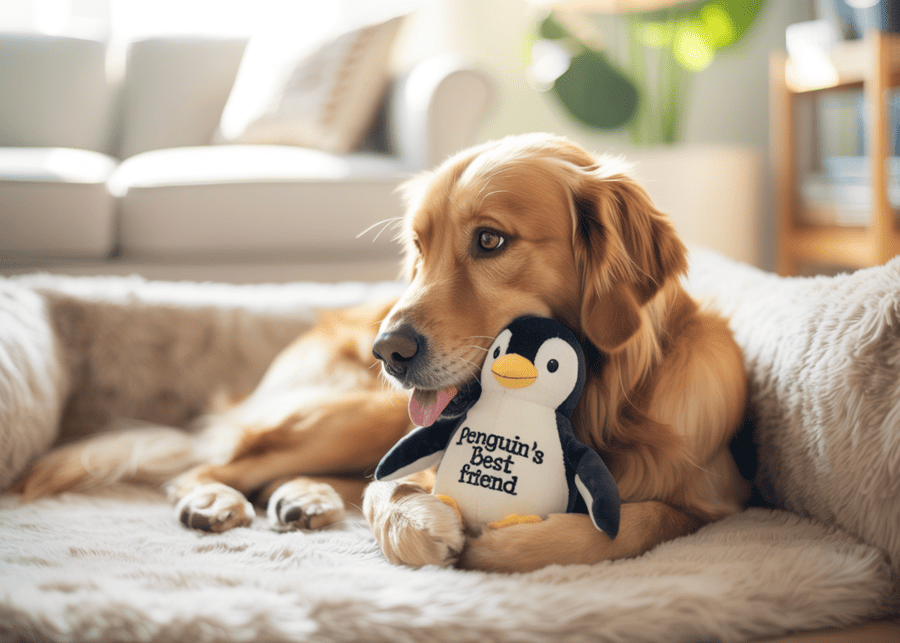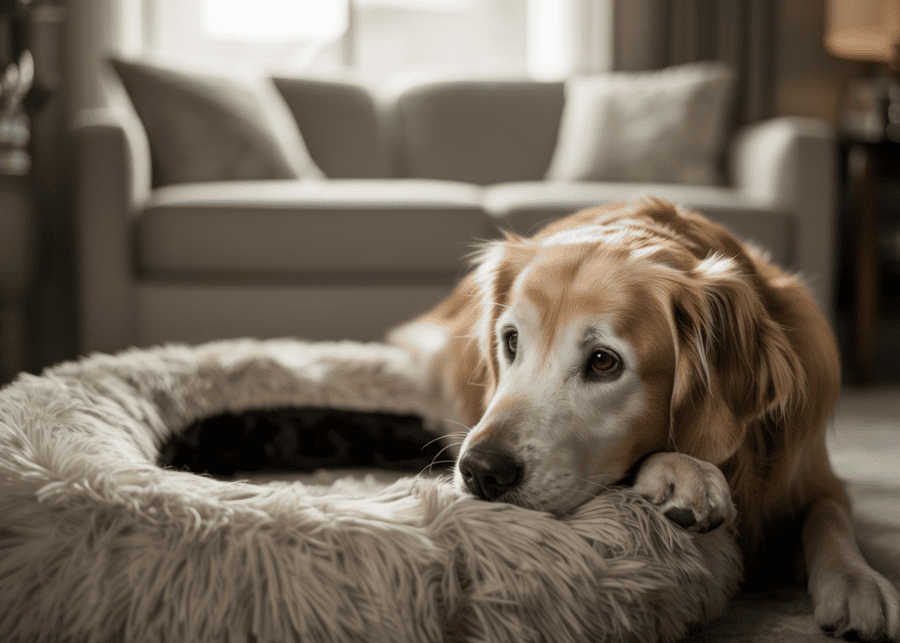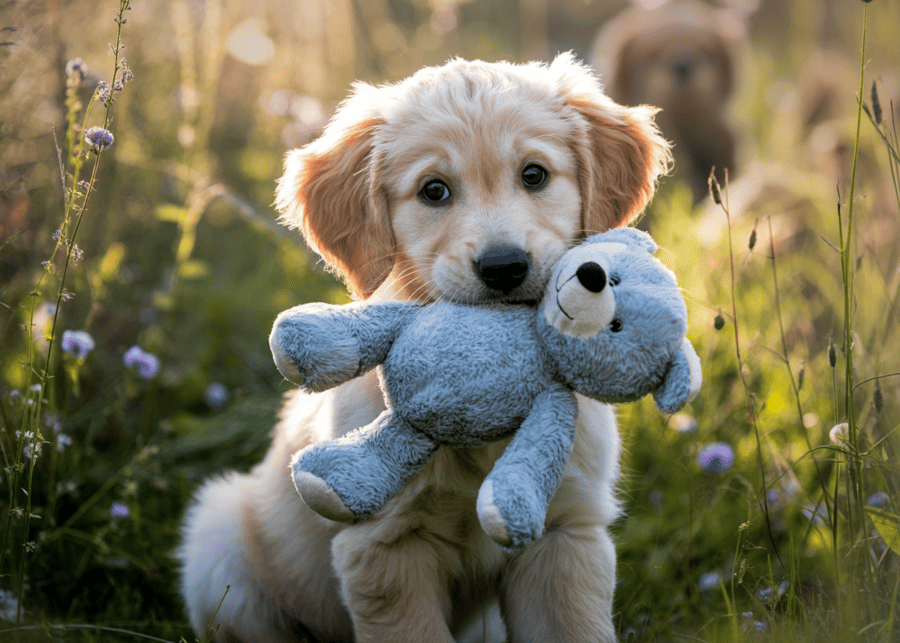Ever watch your dog fiercely shake a squeaky toy and wonder what’s going on in their head? It’s a confusing, yet fascinating, display of instinct.
Yes, dogs likely know their toys aren’t alive on a rational level. They don’t have a heartbeat or real animal scent. However, they engage in a form of pretend play, emotionally treating the toy as if it were real prey or a companion.
This blend of knowing and pretending is fascinating. It’s not just cute behavior; it’s a key insight for anyone in the pet products business. I’ve spent over a decade manufacturing pet supplies, and I’ve learned that this "cognitive suspension" is the golden rule for designing toys that dogs truly love. It allows them to act on their deepest instincts in a safe, fun way. Understanding this helps us create products that build a real bond between a pet and its owner. Let’s explore this idea further.
Do dogs think their toys are animals?
Your dog treats its plush squirrel like real prey, thrashing it around. Does it actually believe it caught a live animal? It’s a common and valid question.
Dogs don’t likely believe their toys are real animals, but they do treat them as substitutes. The toy’s look, feel, and sound trigger their prey drive. It’s a safe way for them to act on ancient instincts without needing to hunt actual prey.

In my experience, this is best explained by what I call the "Semi-Real Theory" of toy design. A dog’s perception isn’t black or white; it’s a spectrum. When a dog gets a new toy, especially one that squeaks or has a fur-like texture, it enters a "honeymoon phase." In this stage, the toy is a direct stand-in for prey. The dog is completely invested, shaking, tossing, and "killing" it. This behavior taps directly into their core hunting instincts. As time passes and the toy becomes a familiar part of their environment, the perception shifts. It’s no longer a new "animal" to conquer. Instead, it becomes a tool for play, like for a game of fetch, or a source of comfort. Understanding this progression is critical for us as manufacturers. We design toys to maximize that initial "semi-real" engagement because we know that’s the hook that creates a lasting bond.
Can a dog think a toy is her baby?
Have you seen a female dog gently carry a soft toy, nesting with it? It looks just like motherly behavior. You might wonder if she’s confused.
Yes, a dog can treat a toy like her baby. This is especially common in female dogs due to hormonal shifts, such as during a false pregnancy. They are projecting maternal instincts onto a soft, comforting object, treating it with care instead of as prey.

This behavior showcases the incredible emotional range dogs have with their toys. A single toy’s role can change from prey to companion to even a "baby." This is a powerful form of emotional projection1, where the toy becomes a source of comfort rather than an object for rough play. We see this demand reflected in our ODM requests all the time. Clients often ask for softer, cuddlier toys specifically for this purpose. For these "nurturing" toys, we focus on features like ultra-soft plush materials, a lighter weight so it can be carried gently, and soft crinkle sounds instead of aggressive squeakers. Understanding this allows us as manufacturers, and the brands we serve, to create products for different emotional needs, not just for play. It helps our clients build a diverse product line that caters to the full spectrum of dog behavior.
How long can a dog remember a toy?
You found an old, forgotten toy under the sofa, and your dog instantly lit up with recognition. It makes you wonder how deep their memory for these objects really goes.
A dog’s memory for a toy is tied to emotional connection. While their short-term memory is limited, positive associations—like fun, comfort, or owner interaction—can make them remember a specific toy for years, especially if it was a favorite.
A dog’s brain excels at associative memory2. They might not remember the day they got the toy, but they absolutely remember the feeling it gives them. "This rope toy means a fun game of tug with my human." "This soft plushy means it’s time to cuddle and relax." Scent plays a huge role here. A toy that holds a familiar scent—the dog’s own, or their owner’s—can trigger this positive memory instantly, even after a long time. As manufacturers, this is a key insight. We advise our clients to choose durable materials that can retain scent over time. This design choice helps a toy move through the "Toy Lifecycle" and become a cherished comfort object that’s deeply embedded in the dog’s long-term memory. This is the ultimate goal for any brand wanting to create a true "favorite" toy.
Do dogs get sad when they lose a toy?
You’ve searched everywhere, but your dog’s favorite squeaky hedgehog is gone. Your dog seems down and keeps looking for it. Can they really be grieving for a lost toy?
Yes, dogs can show signs of sadness or anxiety when they lose a favorite toy. This is because the toy isn’t just an object; it’s a source of comfort, security, and routine. Losing it can disrupt their sense of stability and predictability.

The sadness isn’t about the object itself, but its emotional value. For many dogs, a favorite toy is a "transitional object," much like a child’s security blanket. It’s a constant, reliable source of comfort. When it disappears, they can become lethargic, whine, or lose interest in other activities. This emotional attachment is a powerful insight for pet brands. It underscores the critical importance of durability. A toy that breaks or gets lost easily creates a negative experience for both the dog and the owner. When we consult with our clients, like Judy from Germany who owns a pet store chain, we emphasize choosing high-quality materials. We help them build a reputation for providing reliable, long-lasting toys, which in turn builds immense customer trust and loyalty.
What toy features trigger the strongest emotional responses in dogs?
Some toys get ignored in the toy basket, while others become instant, inseparable favorites. Why the stark difference? The secret is in the details that trigger a dog’s deepest instincts.
The strongest emotional responses are triggered by features that mimic prey. Squeakers sound like a small, distressed animal, while textures like plush or fleece feel like fur. Movement and the ability to be "killed" (shaken and tossed) are also highly engaging for a dog.
After more than 10 years of manufacturing pet toys, I’ve learned that success comes from what I call "Cognitive Arbitrage3." We are essentially using a dog’s cognitive biases to create maximum engagement. It’s not about perfectly replicating an animal; it’s about idealizing the most stimulating parts to create a "super-stimulus."
| Feature | Why It Works | Our Design Approach |
|---|---|---|
| Sound | The squeak mimics the high-pitched sound of prey. | We source various squeakers—high-pitch, low-pitch, grunters—to match different "prey" types and dog sizes. |
| Texture | Plush, fleece, or faux fur feels like an animal’s coat. | We source durable yet soft materials that provide a satisfying mouth-feel without falling apart easily. |
| Durability | The toy must withstand being "killed" repeatedly. | We use reinforced seams and tough fabrics like canvas or ballistic nylon for dogs that are aggressive chewers. |
| Scent | Attracts the dog and encourages investigation and play. | We can infuse toys with long-lasting, pet-safe scents like beef or chicken to keep the dog’s interest. |
This isn’t about tricking the dog. It’s about giving them a safe and deeply satisfying outlet for their natural, hard-wired behaviors.
How do successful pet brands design toys that dogs bond with?
Building a best-selling pet toy line isn’t about luck; it’s a science. The brands that consistently succeed are the ones who know how to turn a simple object into a cherished companion.
Successful brands design toys by focusing on the "Toy Lifecycle." They create a toy that is exciting at first (with prey-like features) but is also durable and comforting enough to become a long-term companion. They understand the dog’s journey from play to emotional attachment.
We work closely with brands to help them design products that navigate this lifecycle. A perfect example is a client of ours, Garrett from the USA. He owns a successful brand of pickleball paddles. He noticed that many of his customers brought their dogs to events, where the pets often seemed bored. He came to us with a unique ODM request: create a plush dog toy that looked exactly like his best-selling paddle. This was a brilliant brand-extension strategy. For the dog, the toy was a new, fun object to "kill" and play with. For the owner, it strengthened their connection to Garrett’s brand. We engineered it to be durable enough for play but soft enough for cuddling. This toy successfully moved through the entire lifecycle, from an exciting "prey" object to a nostalgic comfort item.
Do different dog breeds perceive toys differently?
A Golden Retriever gently carries its plush toy, while a Jack Russell Terrier tries to destroy it completely. Why do different breeds interact with the same exact toy so differently?
Yes, breeds perceive toys differently based on the job they were originally bred for. Retrievers may see a toy as something to fetch and carry gently. Terriers might see it as vermin to be shaken and "killed." Herding breeds may try to nudge and control it.
A dog’s breed is a blueprint for its behavior. For centuries, humans bred dogs for specific jobs, and those powerful instincts are still very much alive today. When we design and manufacture toys, we absolutely must consider this. It’s fundamental to creating a product that a dog will actually use and enjoy.
| Breed Group | Core Instinct | Ideal Toy Preference |
|---|---|---|
| Retrievers | To carry things gently in the mouth | Soft plush toys, balls for fetching, frisbees |
| Terriers | To hunt and kill small vermin | Squeaky toys, "indestructible" toys for shaking |
| Herding Dogs | To control and direct movement | Large balls they can push and "herd" (e.g., Treibball) |
| Sighthounds | To chase fast-moving objects | Lure toys, flirt poles, lightweight fetch toys |
| Scent Hounds | To follow a trail and investigate | Puzzle toys, snuffle mats, treat-dispensing toys |
As a manufacturer, we advise our B2B clients to think deeply about their target customer’s pets. If a brand is popular with terrier owners, their toy line must focus on durability and satisfying squeakers. This targeted approach is far more effective and leads to much more successful and beloved products.
Conclusion
Dogs know their toys aren’t alive, but love to pretend. Understanding this wonderful paradox is the key to designing toys that satisfy their instincts and win their hearts. At Preeminent, we turn this insight into best-selling OEM/ODM toys that build your brand and win hearts everywhere.
-
Exploring emotional projection in dogs can deepen your understanding of their behavior and needs. ↩
-
Understanding associative memory can help you appreciate how dogs form emotional connections with their toys. ↩
-
Explore this concept to understand how it enhances dog engagement and toy effectiveness. ↩


